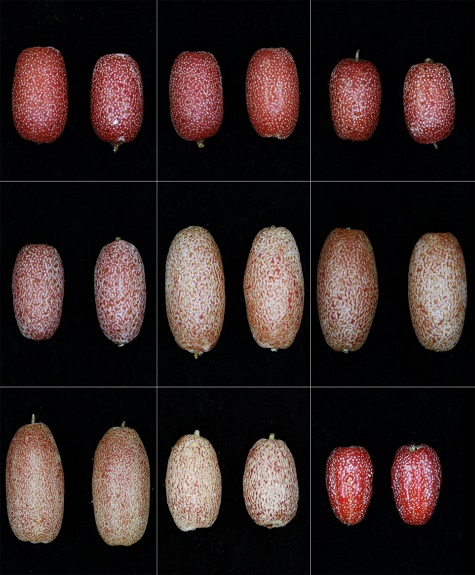Determination of Carotenoids in Fruit of Five Elaeagnus spp. Genotypes by High Performance Liquid Chromatography
- College of Chemistry and Life Sciences, Zhejiang Normal University, Jinhua 321004, China
? These authors contributed equally to this paper
Received date: 2015-06-15
Accepted date: 2015-07-24
Online published: 2016-05-24
Abstract
This study analyzed carotenoid types and content in the fruit of several Elaeagnus spp. including 4 ecotypes of E. pungens, 2 varieties of E. macrophylla, E. glabra, E. magna and E. argyi, by high performance liquid chromatography (HPLC). Lycopene is the major carotenoid in the fleshy pulp, and their content differed between the 5 genotypes. The greatest mean lycopene content was up to (259.89±26.22) µg·g-1 fresh weight (FW) in E. pungens from Shengzhou of Zhejiang and the lowest was (91.19±7.74) µg·g-1 FW in E. argyi. The lycopene content was high in all 4 ecotypes of E. pungens. The flesh of the 5 Elaeagnus spp. showed abundant lycopene, for beneficial fruit resources with important development and application value. These genotypes are also ideal research material for studying the mechanism of high accumulation of lycopene in fruit.

Cite this article
Ling Yang , Zhenxia Cheng , Lingyan Li , Jianhua Chen , Haitao Hu . Determination of Carotenoids in Fruit of Five Elaeagnus spp. Genotypes by High Performance Liquid Chromatography[J]. Chinese Bulletin of Botany, 2016 , 51(3) : 306 -310 . DOI: 10.11983/CBB15106
References
| [1] | 崔大方, 付勉兴, 陈考科, 刘柯 (2008). 广东省胡颓子属植物种质资源及果实利用评价. 植物资源与环境学报 17, 57-61. |
| [2] | 胡海涛, 金晓琴, 成龙平, 杨莉, 陈建华, 番汝昌, 杨玲 (2014). 密花胡颓子果实主要类胡萝卜素组分及含量分析. 中国农业科学 47, 1652-1656. |
| [3] | 毛学文 (1997). 披针叶胡颓子果实营养成分的测定. 植物学通报 14(3), 59-60. |
| [4] | 陶俊, 张上隆, 徐建国, 刘春荣 (2003). 柑橘果实主要类胡萝卜素组分及含量分析. 中国农业科学 36, 1202-1208. |
| [5] | 徐晓丹, 郑伟, 钟晓红 (2007). 胡颓子属种质资源开发利用研究进展. 湖南农业科学 5, 44-46. |
| [6] | 杨燕红 (2011). 胡颓子属植物研究进展. 北方园艺 13, 197-201. |
| [7] | Cazzonelli CI (2011). Carotenoids in nature: insights from plants and beyond. Funct Plant Biol 38, 833-847. |
| [8] | Farré G, Sanahuja G, Naqvi S, Bai C, Capell T, Zhu C, Christou P (2010). Travel advice on the road to carotenoids in plants.Plant Sci 179, 28-48. |
| [9] | Fordham IM (2001). Fruit of autumn olive: a rich source of lycopene.Hortscience 36, 1136-1137. |
| [10] | Fordham IM, Zimmerman RH, Black BL, Clevidence BM, Wiley ER (2003). Autumn olive: a potential alternative crop.Acta Horticulturae 626, 437-439. |
| [11] | Guo XL, Yang L, Hu HT, Yang L (2009). Cloning and expression analysis of carotenogenic genes during ripening of autumn olive fruit.J Agric Food Chem 57, 5334-5339. |
| [12] | Xu CJ, Fraser PD, Wang WJ, Bramley PM (2006). Differences in the carotenoid content of ordinary Citrus and lycopene-accumulating mutants.J Agric Food Chem 54, 5474-5481. |